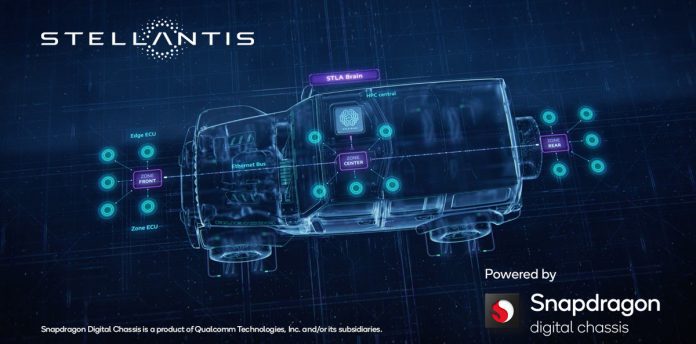Stellantis and Qualcomm collaborating to bring the same type of evolutionary experience expected from smartphones to vehicles
From supplier relations and vertical integration to disaggregating vehicular hardware and software, extending evolutionary experiences to vehicles, and, most importantly, protecting lives, the concept and content of automobiles is changing rapidly. Beyond increasingly robust digital cockpit experiences and powerful infotainment systems, the more impactful vector for digital change in the automotive sector relates to life safety.
As part of its rapid expansion into automotive, Qualcomm in April struck a deal with automaker Stellantis—parent of brands Abarth, Alfa Romeo, Citroen, Chrysler, Dodge, DS Automobiles, Fiat, Jeep, Lancia, Maserati, Opel, Peugeot, and Vauxhall—bringing the tech firm’s Snapdragon Automotive Platforms to the manufacturer’s portfolio beginning in 2024.
To the safety point, which includes a range of technologies under the umbrella of Advanced Driver Assistance Systems (ADAS) with features like lane departure detection and warning, pedestrian detection and avoidance, automatic braking and blind spot monitoring, Stellantis Chief Technology Officer Ned Curic said, “It’s a wonderful thing that the systems are becoming smarter,” and resulting in lives being saved. “It’s like seatbelts. When they got deployed in vehicles, [they] saved so many lives.” ADAS features, he said, “need to be deployed everywhere…That’s a wonderful thing for customers.”
But the hard economics of the situation mean, at least for now, that a more expensive vehicle is going to have more robust safety technologies. So how do you democratize these features? “A life is a life and you need to protect that,” Curic said in conversation with Qualcomm’s Nakul Duggal, senior vice president and general manager of automotive, held during the recent Qualcomm 5G Summit in San Diego. Curic continued: “My goal is to have the most advanced system in every vehicle but that will require our partnership to drop the price. It doesn’t matter if you’re driving a $100,000 vehicle or a $20,000 vehicle…That’s where we’re going.”
More generally on connected vehicular technologies, Duggal noted the delta between the lifecycle of a vehicle and the lifecycle of the tech in that vehicle. So how do you bridge that gap faced with the knowledge that “cars are going to become dependent on the technology they’re sold with” but the technology will continue to develop. “Where does that problem statement fall for you?” he asked Curic.
“You buy a car today, it’s outdated by the time you drive off the lot,” Curic said. In contrast, “You buy a phone, it’s constantly evolving. The customers do expect evolution of the experience…and we have to figure out a way to enable that.” He focused in on separation of hardware and software—interestingly enough a predominant theme in telecommunications networking circles. “It’s much easier to do things in software than it is in hardware. Hardware is expensive, it gets outdated, you have to do lots of custom things. When you can use silicon to do five functions…you do that because, you know, it’s just simpler to do that in software than in hardware.”
Duggal pointed out the move of intelligence off of hardware and into cloud services which themselves are being distributed to the edge. This, to degrees, reimagines a vehicle as something like a thin client device that can be continuously updated with intelligence from the cloud. He said the solutions Qualcomm is building “are becoming more and more heterogeneous” in that they don’t differentiate an ADAS payload from an infotainment payload because the underlying hardware capability needs to support adaptable software abstraction. “You have to have the plumbing in place so the software can adapt to the specific use case.” And to develop that type of forward-architecture, “For us,” Duggal said, “it’s something that really requires a deep understanding of the platform [Stellantis] is building.”
That comment itself speaks to the changing nature of OEM/supplier relationships as the goal becomes to create a vehicle that can evolve with technological advancements. For Stellantis, Curic said, “Everything is getting essentially re-formatted. We don’t know where this journey is going to end in 10 years.” But, he said, “We have to think completely differently [about] who our supplies are, how we manage suppliers, and create strategic partnerships rather than traditional supplier arrangements.”
This aligns with Qualcomm’s approach to automotive, Duggal said, right down to embedding software engineers within automakers. “When you have to own differentiation…it has to be done by ourselves. We are in a way actually being pulled up by the engagements we’re in because that’s what is required.”

